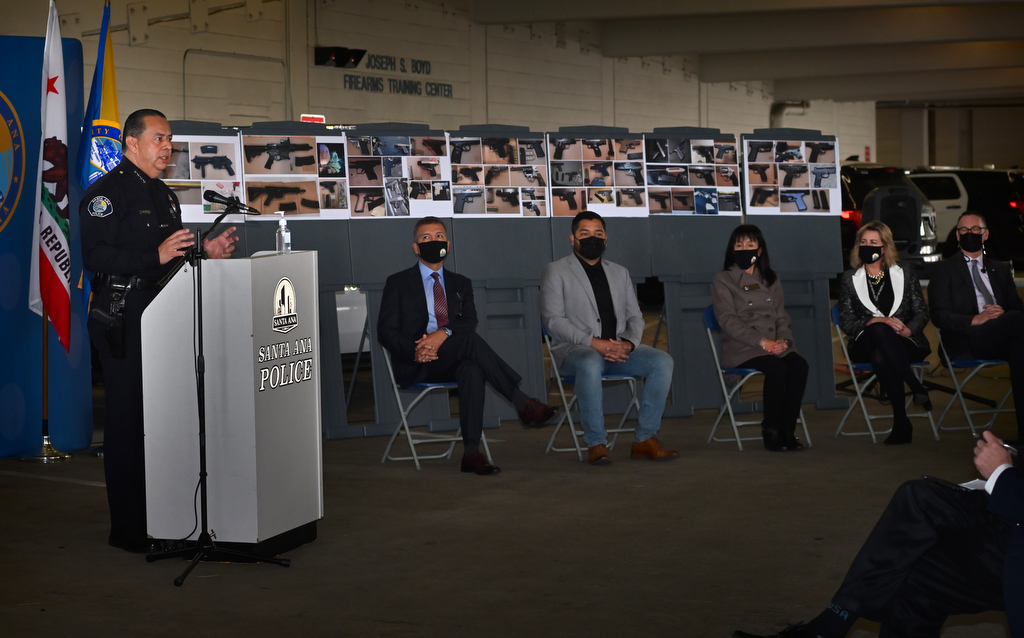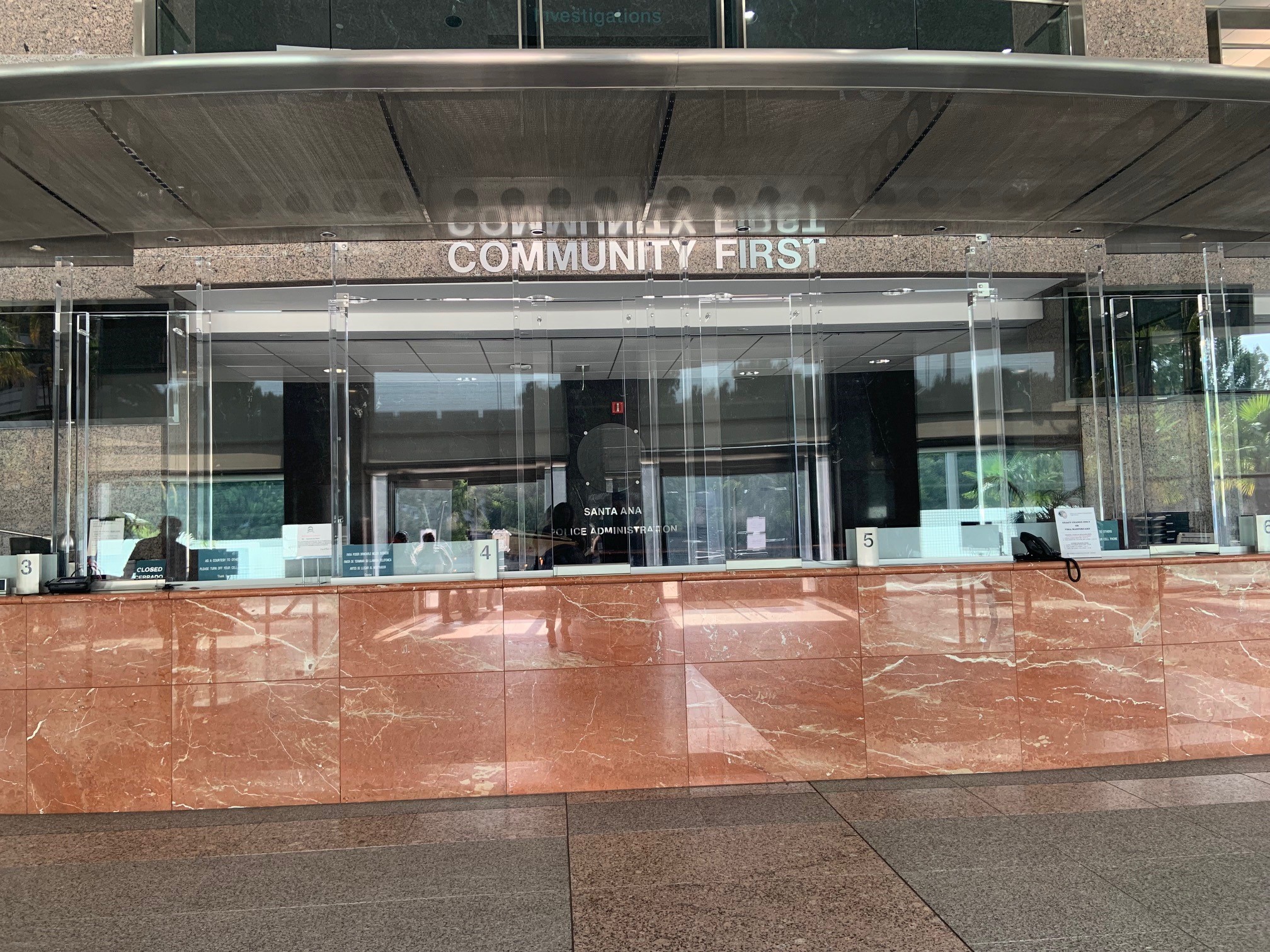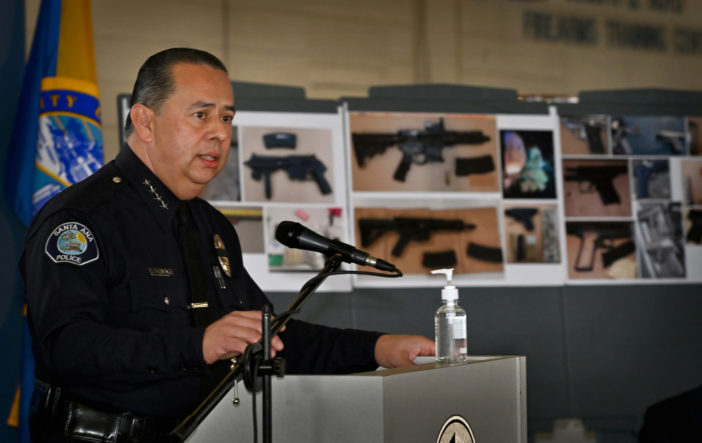As Santa Ana Police Chief David Valentin chatted with a writer, a report came across his desk. His department had seized four firearms from a warrant on an illegal gambling business, or slaphouse.
“Four guns as we’re talking,” Valentin said. “How often has that happened in a press call?”
It’s exactly the kind of outcome the chief envisioned when he launched Operation Community First earlier this year, aimed at staving off the uptick in violent crime in the city and mirrored nationally.
This year through July 13, Santa Ana police officers have seized 200 guns from the streets, compared to 137 through the same time in 2020 — a 46 percent increase.
“We’ve deployed added resources on the streets,” Valentin said of efforts to quash violent crimes that he says are “consistent with what’s going on across the nation.”
Among the focuses of Operation Community First have been ramping up traditional police response and targeting problem areas with specialized units, such as MET. Launched in March 2020, the Major Enforcement Team (MET), is tasked with suppressing the most violent crime. MET emerged from the SAPD’s community-focused 2019-2024 Strategic Plan, co-facilitated with the assistance of the Orange County Human Relations Commission.
Among the targets are the elusive illicit gambling locations that have become a magnet for organized and gang crime, not to mention a danger and a nuisance to the community.
The surge in gun seizures is impressive. However, Valentin is equally impressed with the preventative effect. And though it’s hard to prove a negative or quantify crimes prevented from a specific action, to Valentin the benefits of taking away guns is profound.
“I truly believe that for every gun we remove or seize, you’re potentially saving a life,” Valentin said.

Responding to a year to date increase in violent crime and homicides, Santa Ana Police Chief David Valentin, with council members in attendance, talks about the department’s response with Operation Community First.
Photo by Steven Georges/Behind the Badge
Valentin said he received Integrated Ballistic Identification System, or IBIS, reports from all seized guns, and a number of them have been involved in previous crimes.
As gun ownership and gun crimes have spiked nationally, Santa Ana has not been immune. This was especially true in the first half of the year.
From January 1 through mid-March, the city reported eight homicides compared to just one during the same time period last year. Seven of the eight were related either to gang activity or to illegal gambling houses.
Valentin said the spate of gang shootings precipitated Operation Community First, which is a multi-pronged approach to community policing that stresses enforcement as well as targeting problem areas through data-driven reporting.
“We’ll have a balanced approach moving forward,” the chief said. “You can’t get away from traditional enforcement.”
However, Valentin adds, a commitment to continue to communicate and engage with the community is an essential part of our success.
“They are our eyes and ears,” Valentin said. “We have to always continue to build trust to get them to call us. And you get that from sustained positive engagement.”
Rise of the ghost gun
The guns seized recently at a slaphouse were notable because all four firearms were so-called “ghost guns.”
A burgeoning problem, particularly in California with its tough gun laws, ghost guns represent a troubling trend. With the four recent seizures, Santa Ana has removed 77 ghost guns this year, compared to 29 at the same time in 2020.
The guns, which can be assembled out of kits or with high-tech 3D printers, are troubling because they are made without serial numbers, licensing or oversight. About 30 percent of guns recovered in California in 2019 were ghost guns, according to the Bureau of Alcohol, Tobacco, Firearms and Explosives, and Los Angeles law enforcement reported 41 percent of its seized guns were ghost guns.
President Joe Biden has announced a crackdown on ghost guns and violent crime. Although California has had laws on the books since 2016 aimed at restricting the firearms, the state has had little enforcement due to loopholes in the legislation.
However, the efficacy of those efforts is debatable given the triple digit increases of ghost guns seized in many cities. In Baltimore, officials said they were on pace to seize 300 ghost guns this year, compared to 126 a year ago.
According to Wired magazine, gun activists and makers have become adept at concealing their activities through a decentralized online network where they share print files and advice on the guns.
As technology advances, problem with guns made with 3D printers is expected to accelerate. Although people have been able to make 3D-printed guns at home since 2013, at the time they were essentially one-time, one-shot weapons.
However, according to Slate.com, “Now you can print untraceable AR-15s, AKMs, semi-automatic pistols, and more.”
In addition, when the gun maker was building the guns, they still had to buy magazines, triggers and barrels to complete the kit and build a working gun.
However, on March 30 this year, the design was released online for a 100 percent homemade semi-automatic rifle that can shoot thousands of rounds. Most of the gun is 3D-printed, while the rest includes inconspicuous parts available at hardware stores.
Buybacks considered
In another move to combat gun violence, Valentin is reviewing a proposal for a gun buyback effort. Under such a plan, the police would accept anonymously donated firearms with no questions asked in exchange for gift cards or other incentives.
Los Angeles has had an annual gun buyback program since 2009, operated by the Mayor’s Office of Gang Reduction and Youth Development (GRYD). Since 2013, Los Angeles reports it has removed more than 43,032 firearms from the streets.
In 2013, Santa Ana launched its only gun buyback in the wake of a shooting spree in which a gunman in Orange County killed three people and himself in a string of car jackings.

The Santa Ana Police Department has Community First signage in the police station lobby.
Photo provided by the Santa Ana Police Department
Scholars and experts agree gun buyback programs are effective as part of broader efforts to reduce gun violence, such as education. The programs also increase public confidence in how authorities deal with gun violence and serve as opportunities to educate communities about gun violence reduction strategies, according to academic researchers.
Valentin has mixed feelings about buybacks.
“It’s labor intensive, expensive and a lot of what you end up with is grandpa’s musket from the basement or inoperable guns” he said. “You generally don’t end up with the ghost guns and assault weapons that are being used by criminals in our community.”
However, in keeping with his philosophy that any gun removed is a good thing, Valentin said, “we’re considering it to complement what we’re already doing.”
A national issue
Biden has declared the proliferation of gun violence “an international embarrassment.”
According to the Washington Post, “local leaders are grappling with a possibility they had long feared: that a decades-long era of declining murder rates in America’s cities may be over, and that the increased killings may be here to stay.”
“The thing about violence is that it builds on itself. It cascades,” Princeton sociologist Patrick Sharkey told the Washington Post. “Each shooting brings the possibility of a reprisal.’
In gang areas, this is particularly true, which is part of the reason Santa Ana is keeping close tabs on gang and organized crime activity.
“It’s hard to prevent domestic violence that occurs privately in the home,” Valentin said. “With the gang factor, we have known criminal factors they may be involved in.”
In Los Angeles, there were 171 homicides through June 26, according the Los Angeles Police Department’s online statistics, compared to 137 in 2020 at the same time — a 25 percent increase.
Gun violence isn’t confined to Southern California, it’s everywhere.
In the first quarter of 2021, homicides were up in Atlanta, Chicago, Dallas, Houston, Indianapolis, Orlando, Pittsburgh and Tampa, according to data from the Major Cities Chiefs Association of law enforcement leaders.
While correlation may not be causation, the spike in gun violence does coincide with massive spikes in gun sales.
Gun sales swelled in 2020 to unprecedented heights with the onset of the pandemic, stay-at-home orders, and national protests for racial justice and police reform, according to an analysis by the Washington Post. That surge continued into the start of this year, with sales rising 80 percent over the same time the previous year.
Meanwhile, in Santa Ana, Valentin says he sees the fruit of his efforts.
“I consider that a success; we will stay the course,” he said.
 Behind the Badge
Behind the Badge



